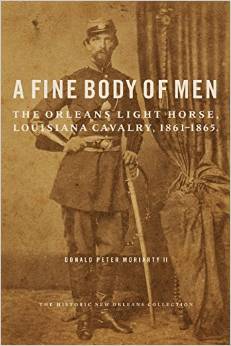A Fine Body of Men: The Orleans Light Horse, Louisiana Cavalry, 1861-1865 by Donald Peter Moriarty II. The Historic New Orleans Collection, 2014. Paper, ISBN: 978-0917860676. $30.00.
 Writing the regimental history of a Civil War unit can be a challenge. Writing a company history, however, takes that challenge to a new level. The additional limitations on potential source material can be daunting.
Writing the regimental history of a Civil War unit can be a challenge. Writing a company history, however, takes that challenge to a new level. The additional limitations on potential source material can be daunting.
In pursuing the Orleans Light Horse, author Donald Moriarty wrestles with exactly this limitation. However, few subjects of a company-level history could be more worthwhile. The men of the Orleans company never served—even nominally—inside a larger regimental or battalion structure. Instead, they served almost the entire war as escort to Confederate General Leonidas Polk and, after his death, as escort to his successors.
As such, they benefit from having been mentioned in the official record far more often than a line company. And given that their original membership was comprised of New Orleans elites, they garnered more home front attention as well. From this material, Moriarty has crafted and interesting and engaging unit narrative.
Readers track the Orleans Horse as they prepare for war in 1861, following their efforts to reach the front, and their attachment to General Polk’s headquarters. As might be expected, their first year of service is well covered; the fall of New Orleans in April 1862 to Union forces and the resultant lapse of pro-Confederate hometown newspaper coverage, however, thins out subsequent documentation.
Fortunately, there is enough of a written record to be able to follow the company through many of the most famous campaigns of the Army of Tennessee. Their story is that of General Polk, for they went where he went. After Polk’s death, they served General Alexander P. Stewart in the same capacity. Their most important duties were providing headquarters security, riding as couriers, and serving as escorts; local reconnaissance also sometimes fell to their lot.
This assignment placed them very close to the center of the Army of Tennessee’s command structure and, sometimes, at the very heart of controversy. In September 1863, some of their members played a role in one of the most significant controversies of the war: Polk’s failure to mount a dawn attack on September 20 at Chickamauga. On the night of the 19th, Bragg placed Polk in charge of General Daniel Harvey Hill, expecting him to relay the attack orders to Hill. Deep in the night, couriers went out from Polk’s headquarters, including some men from the Orleans Light Horse. Hill, however, could not be located, and so his men, who were to spearhead the assault, did not get those orders in a timely fashion. The result was a four-hour delay, during which time the federal army entrenched.
Moriarty’s narrative of the company outlines this and other important happenings involving the command, but not always in much detail. The greatest strength of this work is in the detailed biographical and statistical data on the approximately 215 men who served in the company. While the historical narrative covers 100 pages, encompassing secession to the company’s final surrender in North Carolina, the service record portion of the book occupies pages 114 to 280. Each man’s birth and death, dates of enlistment and muster-out, and, in some cases, milestones of service are included. Genealogical data, occupations, marriages, and the like are often also included. One appendix includes the constitution and by-laws of the original militia unit, while a second lists known burial places.
All of this data provides some very useful glimpses into the strength and composition of the command. The unit strength is provided for every couple of months, giving those present, absent, gains and losses (either killed or discharged) and sick. As might be expected of a unit of such social stature, the make-up included a great many professional men and skilled laborers. Among others, merchants, physicians, a surveyor, a couple of physicians, a “customs weigher,” and several planters all served in the unit.
This reviewer wishes that the author had taken things one step further and assembled that information into a more accessible format: detailing the number of men in each profession, for example, rather than having to hunt entry by entry. Similarly, one keeps hoping for more detail in the narrative in the form of personal letters, newspaper correspondence, and the like. This work has little of that material, perhaps because none has survived. If so, alas.
Additionally, while the volume is well illustrated, only three member portraits are included: the three commanders, Captains John M. Taylor, Thomas L. Leeds and J. Leeds Greenleaf. Given the relative wealth and social standing of so many of the members, other pictures remain to be found.
That said, Mr. Moriarty has done a remarkable job, especially with regard to statistical, genealogical, and military data. The work is both meticulous in its attention to detail as well as an interesting read.
David A. Powell is the author of numerous articles on Civil War topics, as well as The Maps of Chickamauga (2009), Failure in the Saddle (2010), The Chickamauga Campaign: A Mad Irregular Battle (2014), and The Chickamauga Campaign: Glory or the Grave (2015).




